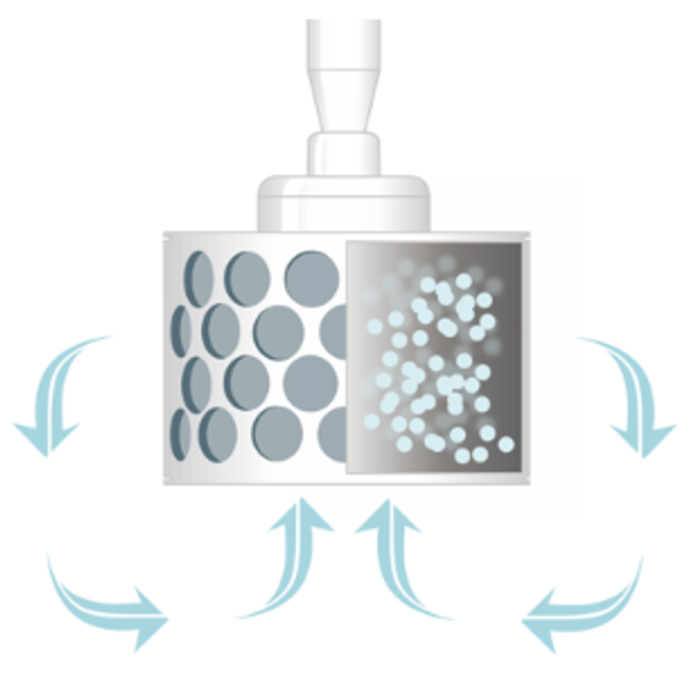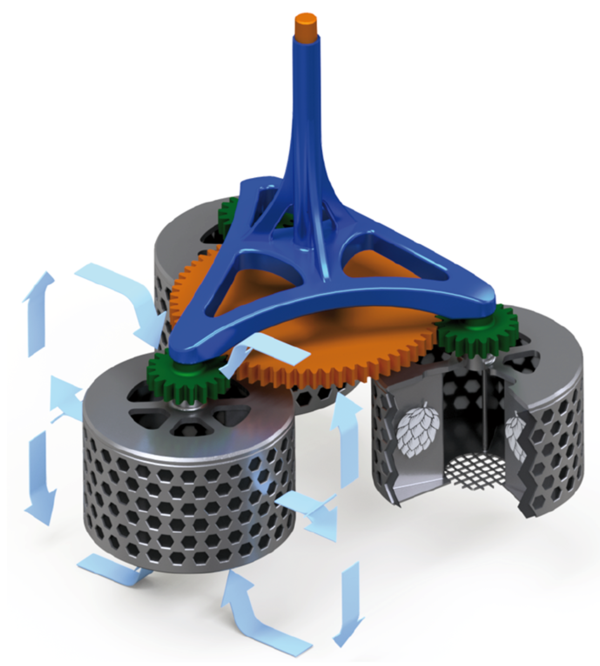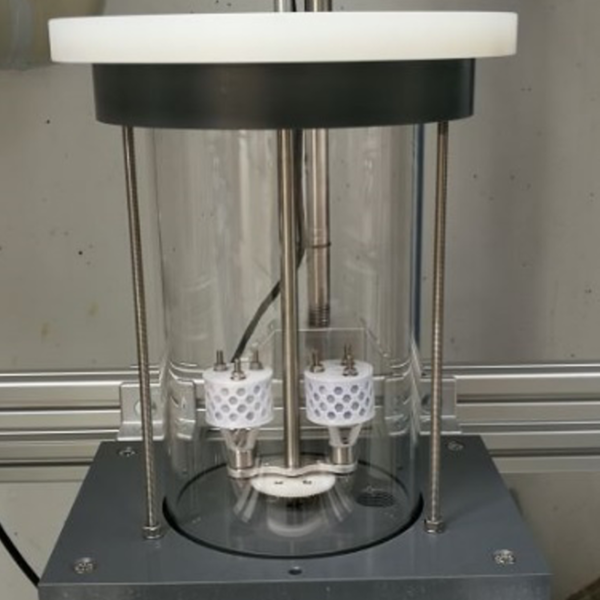Case Study
Heidolph Laborrührer mischen bei der Hopfenextraktion mit
March 2022
- Hei-TORQUE
- Extrahieren
- Grundlagenforschung
- Lebensmittelindustrie
- Rühren
With their innovative solid-liquid reactor, researchers at the Chair of Food Chemistry and Molecular Sensor Technology at TUM (Technical University of Munich) have developed an efficient and scalable technology for heterogeneous reactions. The planetary rotating reactor, which combines a high mass transfer with a solid-liquid separation, is thoroughly tested for its practical suitability with Hei-TORQUE laboratory stirrers.
Substantial modeling: Extraction of hop aromas
 “From a purely physical point of view, the binding of disruptive substances to fine solid particles works very well. With our solid-liquid reactor, we want to put this PS on the road in terms of process technology."
“From a purely physical point of view, the binding of disruptive substances to fine solid particles works very well. With our solid-liquid reactor, we want to put this PS on the road in terms of process technology."
Christian von Heynitz, Filtration Project Manager at the Technical University of Munich
The fact that Christian von Heynitz, Manuel Stecker and their co-authors chose a model-based feasibility study for efficient dry-hopping in the brewing process for the first paper on their planetary rotating reactor for solid-liquid reactions is extremely consistent. They do research and teach at the TUM School of Life Sciences on the Weihenstephan Campus in Freising, which is located right next to the largest contiguous hop growing area in the world, the Hallertau.
The hop tamping, also called dry hopping was rediscovered by the brewers' guild with the craft beer trend. In order to intensify the hop aroma lost after cooking or to enrich the beer with specific aroma combinations, the aromas - especially the important hop oil - are extracted from dry hop pellets that are added to the storage tank with the active help of the alcohol in the beer. This happens at low temperatures of 1 to 20° C. However, the following always applies: the smaller the hop particles, the more efficient the extraction, as there is a larger reactive surface.
Christian von Heynitz explains: “Regardless of whether you want to purify water, brew coffee or produce vaccines: the basic procedural operation of the solid-liquid reaction is always the same. For reasons of cost efficiency and ecological responsibility, it is preferred to work with the smallest possible particle sizes. Unfortunately, it is precisely these that cause major problems in the process.” With established processes, small particle sizes often lead to clogging or poor material transport behavior. In addition, they cause considerable filtration effort. The consequences of dry hopping: High losses of the valuable and also expensive raw material hops, high expenditure of time and high beer loss.
The solution: a planetary rotating reactor for solid-liquid reactions
If the hop pellets are statically introduced into the storage tank, the particles inevitably sink to the bottom. So they have to be kept moving in order to release as much aroma as possible in the shortest possible time. The solid-liquid reactor developed at TUM, for which the patent was granted in January 2021, is a further development of the RBR operating principle. With the still relatively new Rotating Bed Reactor (Fig. 1), the solid bed of particles is located within a perforated cylinder rotating around the vertical axis. The rotary motion causes a continuous flow of the fluid through the fixed bed and thanks to the centrifugal force the mass transport rate increases.
In practice, however, particles that are too small often lead to a dense filter cake that can clog the filter. In order to prevent this and at the same time to maximize flow speeds and material transport, the team at TUM constructed a PRBR from the RBR: a Planetary Rotating Bed Reactor (Fig. 2), in which two centripetal movements overlap. The reactor chambers not only rotate around their own axis, but also move on a circular path with the help of a planetary gear. An idea that is also ingenious thanks to its simplicity: The centrifugal forces suck the surrounding beer through openings on the top and bottom into the reactor chambers with the packed hop solids and ensure a continuous extraction, as the solids are flowed through radially outwards. At the same time, periodic centrifugal forces keep the particles oscillating within the reactor chambers and prevent the filter fabric from clogging.
Fig.1: Sketch of a Rotating Bed Reactors (RBR) with indicated flow pattern (source: http://www.spinchem.com/technology/#prettyPhoto)

With their innovative solid-liquid reactor, researchers at the Chair of Food Chemistry and Molecular Sensor Technology at TUM (Technical University of Munich) have developed an efficient and scalable technology for heterogeneous reactions. The planetary rotating reactor, which combines a high mass transfer with a solid-liquid separation, is thoroughly tested for its practical suitability with Hei-TORQUE laboratory stirrers.
Substantial modeling: Extraction of hop aromas
 “From a purely physical point of view, the binding of disruptive substances to fine solid particles works very well. With our solid-liquid reactor, we want to put this PS on the road in terms of process technology."
“From a purely physical point of view, the binding of disruptive substances to fine solid particles works very well. With our solid-liquid reactor, we want to put this PS on the road in terms of process technology."
Christian von Heynitz, Filtration Project Manager at the Technical University of Munich
The fact that Christian von Heynitz, Manuel Stecker and their co-authors chose a model-based feasibility study for efficient dry-hopping in the brewing process for the first paper on their planetary rotating reactor for solid-liquid reactions is extremely consistent. They do research and teach at the TUM School of Life Sciences on the Weihenstephan Campus in Freising, which is located right next to the largest contiguous hop growing area in the world, the Hallertau.
The hop tamping, also called dry hopping was rediscovered by the brewers' guild with the craft beer trend. In order to intensify the hop aroma lost after cooking or to enrich the beer with specific aroma combinations, the aromas - especially the important hop oil - are extracted from dry hop pellets that are added to the storage tank with the active help of the alcohol in the beer. This happens at low temperatures of 1 to 20° C. However, the following always applies: the smaller the hop particles, the more efficient the extraction, as there is a larger reactive surface.
Christian von Heynitz explains: “Regardless of whether you want to purify water, brew coffee or produce vaccines: the basic procedural operation of the solid-liquid reaction is always the same. For reasons of cost efficiency and ecological responsibility, it is preferred to work with the smallest possible particle sizes. Unfortunately, it is precisely these that cause major problems in the process.” With established processes, small particle sizes often lead to clogging or poor material transport behavior. In addition, they cause considerable filtration effort. The consequences of dry hopping: High losses of the valuable and also expensive raw material hops, high expenditure of time and high beer loss.
The solution: a planetary rotating reactor for solid-liquid reactions
If the hop pellets are statically introduced into the storage tank, the particles inevitably sink to the bottom. So they have to be kept moving in order to release as much aroma as possible in the shortest possible time. The solid-liquid reactor developed at TUM, for which the patent was granted in January 2021, is a further development of the RBR operating principle. With the still relatively new Rotating Bed Reactor (Fig. 1), the solid bed of particles is located within a perforated cylinder rotating around the vertical axis. The rotary motion causes a continuous flow of the fluid through the fixed bed and thanks to the centrifugal force the mass transport rate increases.

Fig.1: Sketch of a Rotating Bed Reactors (RBR) with indicated flow pattern (source: http://www.spinchem.com/technology/#prettyPhoto)
In practice, however, particles that are too small often lead to a dense filter cake that can clog the filter. In order to prevent this and at the same time to maximize flow speeds and material transport, the team at TUM constructed a PRBR from the RBR: a Planetary Rotating Bed Reactor (Fig. 2), in which two centripetal movements overlap. The reactor chambers not only rotate around their own axis, but also move on a circular path with the help of a planetary gear. An idea that is also ingenious thanks to its simplicity: The centrifugal forces suck the surrounding beer through openings on the top and bottom into the reactor chambers with the packed hop solids and ensure a continuous extraction, as the solids are flowed through radially outwards. At the same time, periodic centrifugal forces keep the particles oscillating within the reactor chambers and prevent the filter fabric from clogging.

Fig. 2: Virtual 3D model of the Planetary Rotating Bed Reactors (PRBR) with a view of the reactor chamber and indicated flow pattern (Source: A Novel Dry Hopping Technology: Kinematic Modelling of a Planetary Rotating Bed Reactor
From theory to practical test

“We are currently testing various Heidolph hardware components. You could say "everything about agitators" - from the Hei-TORQUE Precision 400 to the flexible shaft, up to the flexible agitator coupling.”
Manuel Stecker, research assistant at the Technical University of Munich
The team led by von Heynitz and Stecker has already constructed a first prototype of the planetary rotating reactor on a laboratory scale (Fig. 3) in order to experimentally confirm the findings from the mathematical model. For example, the extraction efficiency and the retention of solids in relation to the flow rate are quantified. A Hei-TORQUE Precision 200 laboratory stirrer and a Hei-TORQUE Precision 400 with self-designed stirrer blades are used. The agitator shaft is led out of the device at the top (Fig. 4). Heynitz goes into raptures: “Heidolph belongs to a small group of manufacturers of very powerful agitators. This is particularly important for our process and our scaling plans. As an engineer, you tend to make very analytical and number-based decisions. I have to admit, however, that the first Hei-TORQUE device that I held in my hands left a lasting impression of quality. I have a lot of sympathy and passion for “Made in Germany” and especially for German medium-sized companies. After we found the contact with the application specialists at Heidolph productive and pleasant, the cooperation on our part was in principle already sealed. We encountered an extraordinary amount of curiosity, openness to innovation and willingness to help."
 Fig. 3: Prototype of the Planetary Rotating Bed Reactors (PRBR)
Fig. 3: Prototype of the Planetary Rotating Bed Reactors (PRBR)
 Fig. 4: Prototype of the Planetary Rotating Bed Reactors (PRBR) driven by two Hei-TORQUE Precision laboratory stirrers
Fig. 4: Prototype of the Planetary Rotating Bed Reactors (PRBR) driven by two Hei-TORQUE Precision laboratory stirrers

"I actually don't see any laboratory stirrers per se in Hei-TORQUE devices, but high-quality, high-performance process drives based on direct current.”
Christian von Heynitz, Filtration Project Manager at the Technical University of Munich
"So much concentrated praise almost makes us a bit embarrassed, but of course also spurs us on. We would like to thank Christian von Heynitz and Manuel Stecker and their team at the Chair of Food Chemistry and Molecular Sensor Technology for their trust and cooperation on this user report."
Team Heidolph
Sources:
- Patent specification at the European Patent Office https://data.epo.org/publication-server/document?iDocId=6450535&iFormat=0
- A Novel Dry Hopping Technology: Kinematic Modelling of a Planetary Rotating Bed Reactor https://www.brewingscience.de/index.php?tpl=table_of_contents&year=2020&edition=0005%2F0006&article=92751


